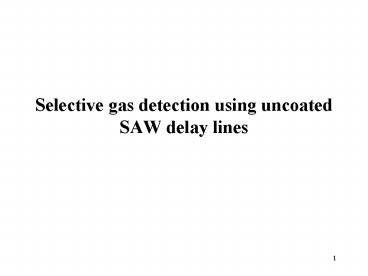Selective gas detection using uncoated SAW delay lines PowerPoint PPT Presentation
Title: Selective gas detection using uncoated SAW delay lines
1
Selective gas detection using uncoated SAW delay
lines
2
Introduction
- The attractive properties of acoustic wave
sensing - The principle of acoustic wave sensing
- The sensing properties are dependent on the test
gas and material of the film - The detection principle of the uncoated SAW gas
sensor - The limitation of the uncoated SAW gas sensor
3
Experimental
- Substrates (001),lt110gtBi12SiO20 and AT, X-SiO2
- Untuned insertion loss 20 dB
- Operation frequency 20 MHz(Bi12SiO20) and 156
MHz(SiO2)
4
- Operating temperature 25-100oC
- Test cell 250 ml
- Flow rate 500 ml min-1
- The flow of the gases injected into the cell was
perpendicular to the SAW substrate - Reference gas Ar and N2
- Reference gas (at least two hours)?test gas (20
min)?reference gas - Noise level ???? 2 ppm
5
Results and discussion
- Selective operation of the sensor is suggested by
vanishing ?? or TCD for a given gas of two test
gases - When ?? or TCD are zero, the SAW response is zero
6
The vanishing of ??(T)
- The large ?? , the higher is the sensor response
and lower is the minimal detectable level - ?? n?rg(T)-?tg(T)
7
- The vanishing ?? for EtOH is achieved at a given
temperature without the vanishing of ?? for CH4
at the same temperature - The SAW responses accord with behaviour of ??(T)
8
- The SAW response for EtOH vanishes at 73oC, while
the SAW response for CH4 reaches 1800ppm at the
same temperature - It confirms the selective operation towards EtOH
9
Vanishing of TCD(T)
- The crossing zero is at 77oC
- The SAW response is increased or decreased by the
proper selection of the operation temperature
10
- Vanishing of the SAW Ar response achieved at 73oC
- The sign change of the response to Ar is related
to the sign change of the TCD
11
- For the optimum temperature, The SAW response
towards He is higher than that for Ar
12
- The injection of He(??lt0) decreases the
temperature of substrate - The injection of Ar(??gt0) increases the
temperature of substrate - The sensor working around the turnover
temperature is able to distinguish between Ar and
He - The uncoated SAW sensors have not the problems of
film stability and aging
PowerShow.com is a leading presentation sharing website. It has millions of presentations already uploaded and available with 1,000s more being uploaded by its users every day. Whatever your area of interest, here you’ll be able to find and view presentations you’ll love and possibly download. And, best of all, it is completely free and easy to use.
You might even have a presentation you’d like to share with others. If so, just upload it to PowerShow.com. We’ll convert it to an HTML5 slideshow that includes all the media types you’ve already added: audio, video, music, pictures, animations and transition effects. Then you can share it with your target audience as well as PowerShow.com’s millions of monthly visitors. And, again, it’s all free.
About the Developers
PowerShow.com is brought to you by CrystalGraphics, the award-winning developer and market-leading publisher of rich-media enhancement products for presentations. Our product offerings include millions of PowerPoint templates, diagrams, animated 3D characters and more.

